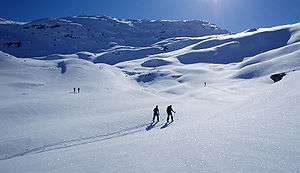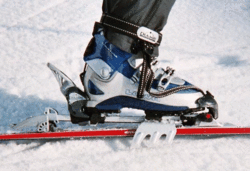Ski touring

Ski touring is a form of skiing where both uphill and downhill travel are possible without needing to remove skis.[1] Typically touring is done off-piste and outside of ski resorts. Tours can often extend over a period of more than one day. Typically, skis, bindings, and boots allow for free movement of the heel to enable a walking pace, as in Nordic, and unlike in alpine skiing. While ski mountaineering can be practised recreationally or as a competitive sport,[2] touring is always recreational.
Ski touring and ski mountaineering have grown in popularity. It has been adopted by skiers looking for new snow, by alpinists, and by those seeking to avoid the high costs of traditional alpine skiing at resorts.[3]
Touring involves independently navigating and route finding through potential avalanche terrain, and often requires familiarity with meteorology along with skiing skills. Ski touring can also be faster and easier than summer hiking in some terrain allowing for traverses and ascents that would be harder in the summer. Skis can also be used to access backcountry alpine climbing routes when snow is off the technical route, but still covers the hiking trail.
History
The sport's pioneers include:
- John "Snowshoe" Thompson, perhaps the earliest modern ski mountaineer, a prolific traveler who used skis to deliver the mail at least twice a month up and over the steep eastern scarp of the Sierra Nevada to remote California mining camps and settlements. His deliveries began in 1855 and continued for at least 20 years. Thompson's route of 90 miles (140 km) took 3 days in and 48 hours back out with a pack that eventually exceeded 100 pounds of mail.
- Cecil Slingsby, one of the earliest European practitioners, who crossed the 1,550 m (5,090 ft) high Keiser Pass, Norway, on skis in 1880.
- Wilhelm von Arlt (1853–1944), regarded by many as the "father" of the sport, who made the first ski ascent over 3,000 m when he climbed the Rauris Sonnblick (3,103 m; 10,180 ft high) in 1894.
- Orland Bartholomew skied alone over 300 miles (480 km) of California's High Sierra from Cottonwood Creek to Yosemite National Park in 1929, roughly following the line of the summer route now known as the John Muir Trail. This included the first winter ascent of the highest peak in the contiguous United States, Mount Whitney. Bartholomew was self-supported using food caches placed over the summer.
- Adolfo Kind
- Arnold Lunn
- Ottorino Mezzalama
- Paul Ramer
- Patrick Vallençant
- Kilian Jornet Burgada
Technique
As the slope angles increase, the climbing ski-tourer will make switchbacks, using kick turns to change direction, typically resulting in a line that climbs at a moderate angle of 20-30 degrees. Skin tracks can be seen as zig-zags heading up a snowy mountain. Ski-tourers try to maintain the up-tracks in avalanche-safe zones as they head up the mountain, staying out from under dangerous cornices or slide paths. Setting a proper and safe skin track requires a great deal of skill and avalanche knowledge as the tourer spends most of their time climbing. Traveling quickly up the hill is important for safety as well. Thus physical fitness is one of the most important elements of safe mountain travel in potential avalanche terrain.
Ski touring requires the ability to ski off-piste, good navigation skills, and good awareness of the risks of the mountain environment in winter. In particular it requires the knowledge to assess and test snow conditions to minimise the risk of avalanche.
Equipment

- Avalanche rescue equipment.
- Going uphill or across a flat also requires grip, so that the ski will glide forward but not slide backwards when weighted. Dedicated cross-country touring skis may have a fish-scale pattern engraved into the base of the ski to enable the ski to grip, but most types of ski require the use of sticky wax or climbing skins for their smooth surface to grip.
- If the snow is particularly icy or the skin track very steep, then the ski tourer may choose to attach ski crampons, sometimes called Harscheisen (German), couteau (French), or rampant (Italian). Crampons are like knives that cut deeper into the snow.
Styles of equipment:
- Nordic ski touring is skiing with bindings that leave the heels free all the time. Thus, Nordic skiers do not have to change back and forth between uphill and downhill modes, which can be advantageous in rolling terrain. At the lighter, simpler end of the scale, Nordic skis may be narrow and edgeless cross-country types for groomed trails or ideal snow conditions, used with boots that resemble soft shoes or low boots.
- Backcountry Nordic: heavier than a traditional Nordic setup, but not as big and heavy as a full Telemark setup.
- At the heavier end of the Nordic skiing equipment spectrum lie Telemark skis for steep backcountry terrain or ski-area use.
- Alpine Touring (AT) or randonnée equipment is specifically designed for ski touring in steep terrain. A special alpine touring binding is used that allows the heel to be clipped down for more support when skiing downhill, and allows it to be released to swing resistance-free from the toe when climbing.
- Alpine skiing equipment can be used for ski touring with the addition of a removable binding insert that allows for free heel swing on ascents.
Ski Touring Regions

Ski touring can take place anywhere that has suitable snow and terrain. Some examples include
- Iceland: Activities center on the Troll Peninsula in northern Iceland.[4]
- Norway: touring in Norway has a long tradition. Skiing was originally a practical means of winter transportation. Ski touring formed the basis of the polar expeditions of Norwegian explorers like Fridtjof Nansen and Roald Amundsen. There are thousands of kilometers of marked ski routes, both in the forested areas and the mountain areas above the tree-line. The trails are maintained by organizations like Skiforeningen in the Oslomarka area and Norwegian Trekking Association nationally including Hardangervidda, Rondane and Jotunheimen. The Norwegian Trekking Association (Norwegian: Den norske turistforening, DNT) maintains mountain trails and cabins in Norway. The association was founded in 1868. DNT has more than 200,000 members.
- The European Alps: including the Haute Route
- Canada: including Rogers Pass,[5] Wapta,[6] Revelstoke,[7] Golden: in the southeast of the province at the confluence of the Columbia and Kicking Horse Rivers. Surrounded by the Rocky Mountains to the east and the Purcell Mountains and Selkirk Mountains to the west.,[8] Kananaskis Country,[9] and Gros Morne National Park[10]
- U.S.: touring takes place anywhere there is snow in the U.S., for example Jackson Hole,[11]Loveland Pass,[12] and Berthoud Pass[13]
- Ski areas of New Zealand include Arthur's Pass National Park, Central Otago, Fiordland, Aoraki-Mount Cook National Park, Mount Ruapehu, Nelson, Ohau, Wanaka, and the Arrowsmith Range.[14]
See also
References
- ↑ A Complete Guide to Alpine Ski Touring Ski Mountaineering and Nordic Ski Touring Including Useful Information for Off Piste Skiers and Snow Boarders. Authorhouse. 2014. p. xvii. ISBN 978-1491888087. Retrieved 12 July 2014.
- ↑ Volken, Martin; Schell, Scott; Wheeler, Margaret (2007). Backcountry Skiing: Skills for Ski Touring and Ski Mountaineering. Outdoor Expert Series. The Mountaineers Books. p. 339. ISBN 1594850380.
- ↑ Volken, Martin; Schnell, Scott; Wheeler, Margaret (2007). Backcountry Skiing: Skills for Ski Touring and Ski Mountaineering. Mountaineers Books. p. 12. ISBN 978-1594850387. Retrieved 12 July 2014.
- ↑ "Ski Touring". Retrieved 12 July 2014.
- ↑ "Ski Touring in Rogers Pass and The Winter Permit System". Parks Canada. Retrieved 12 July 2014.
- ↑ "The Wapta Traverse". Yamnuska. Retrieved 12 July 2014.
- ↑ "Backcountry Skiing". Retrieved 12 July 2014.
- ↑ "Backcountry Huts". Ski Golden. Retrieved 12 July 2014.
- ↑ "Kananaskis Country". Retrieved 12 July 2014.
- ↑ "Backcountry Ski Huts". Parks Canada. Retrieved 8 February 2015.
- ↑ "Online guide to backcountry skiing on Teton Pass". Retrieved 2010-04-09.
- ↑ "Online guide to backcountry skiing on Loveland Pass". Retrieved 2010-04-09.
- ↑ "Online guide to backcountry skiing on Berthoud Pass". Retrieved 2010-04-09.
- ↑ "Ski Touring New Zealand". Retrieved 28 September 2015.
External links
- United States Ski Mountaineering Association
- Backcountry and avalanche safety info for backcountry adventurers
- International Mountaineering and Climbing Federation